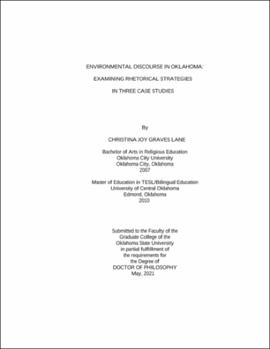| dc.contributor.advisor | Lewis, Lynn | |
| dc.contributor.author | Lane, Christina Joy Graves | |
| dc.date.accessioned | 2021-09-23T19:42:39Z | |
| dc.date.available | 2021-09-23T19:42:39Z | |
| dc.date.issued | 2021-05 | |
| dc.identifier.uri | https://hdl.handle.net/11244/330829 | |
| dc.description.abstract | Despite the acceleration of climate change, figuring out ways to productively talk about it remains difficult in some places. So where do we begin? As rhetoricians, we believe that studying discourse provides insight. Herndl and Brown describe environmental discourse as a historically developed cultural form maintained by rhetorical activity (9). Guided by the type of situatedness encouraged by Cultural Rhetorics, this project interrogates the environmental discourse used in Oklahoma by three actors within the hegemonic public of the non-renewable energy industry - Devon Energy, Scott Pruitt, and the Oklahoma Energy Resources Board (OERB) - as well as one actor within a counterpublic - the Oklahoma Renewable Energy Education Program (OREEP). These particular actors were selected due to their influence within different arenas - industry, government, education - that impact Oklahomans' lives in different ways. Through three case studies, I explore what rhetorical strategies have been used to create, develop, and maintain the environmental discourse of these actors, as well as how these rhetorical strategies frame the environmental discourse of these actors. In my first case study, I examine the responses of Devon Energy to the Carbon Disclosure Project's Climate Change Questionnaire from 2010-2018 using a unique methodological approach that combines grounded theory, in addition to drawing from scholarship in technical communications and rhetorical studies. In the second case study, I scrutinize the tweets of Scott Pruitt from his tenure as the Environmental Protection Agency Head Administrator from 2017-2018 using grounded theory. In the third case study, I analyze OERB's cartoon character, Petro Pete, who appears in their educational curriculum; I also analyze OREEP's cartoon character, Ree Newable, who is their educational mascot. The findings from these case studies reveal similarities in the ways environmental discourse is rhetorically used: a reliance on benevolence, fundamentalist Christian beliefs and values, and a cultural script of whiteness. These findings enabled me to re-imagine Killingsworth and Palmer's seminal environmental rhetoric model that is still referred to today, most significantly through my addition of a Nature as Creation attitudinal orientation (14). | |
| dc.format | application/pdf | |
| dc.language | en_US | |
| dc.rights | Copyright is held by the author who has granted the Oklahoma State University Library the non-exclusive right to share this material in its institutional repository. Contact Digital Library Services at lib-dls@okstate.edu or 405-744-9161 for the permission policy on the use, reproduction or distribution of this material. | |
| dc.title | Environmental discourse in Oklahoma: Examining rhetorical strategies in three case studies | |
| dc.contributor.committeeMember | Daniel, Joshua | |
| dc.contributor.committeeMember | Cheng, An | |
| dc.contributor.committeeMember | Mix, Tamara | |
| osu.filename | Lane_okstate_0664D_17111.pdf | |
| osu.accesstype | Open Access | |
| dc.type.genre | Dissertation | |
| dc.type.material | Text | |
| dc.subject.keywords | environmental discourse | |
| dc.subject.keywords | environmental rhetoric models | |
| dc.subject.keywords | non-renewable energy industry | |
| dc.subject.keywords | rhetorical strategies | |
| thesis.degree.discipline | English | |
| thesis.degree.grantor | Oklahoma State University | |
